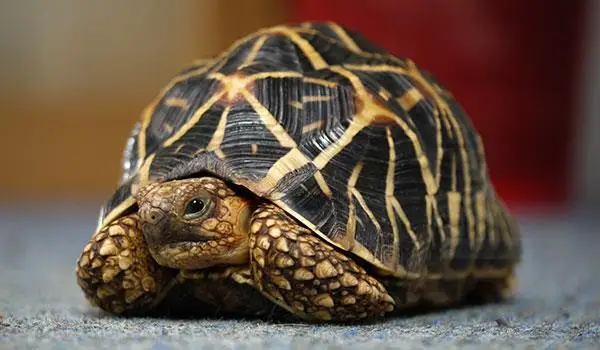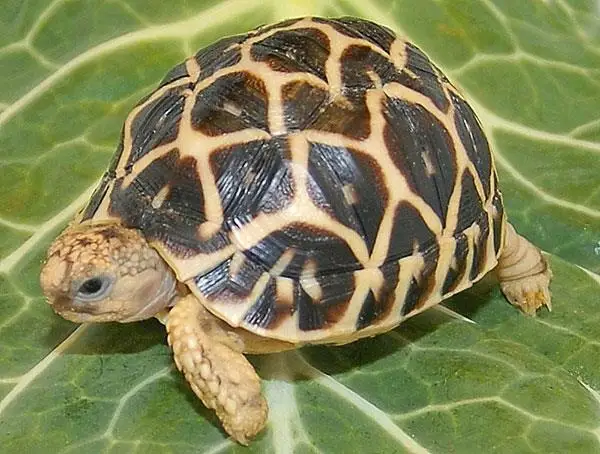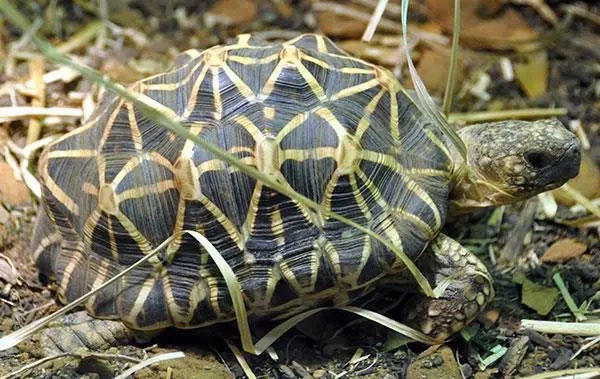Variety Overview
English Name: Indian Star Tortoise
Alias: Indian Star Tortoise
Origin: India, Pakistan, Sri Lanka
Price: approximately $300 USD
Size: 30 to 38 cm (12 to 15 inches)
Lifespan: 30 to 50 years
Morphological Features and Identification
The Indian star tortoise (Geochelone elegans) features fine line patterns that are evenly thick from head to tail. In its natural habitat, the star pattern on its shell acts as camouflage, blending seamlessly into dry grass and making it hard for predators to spot. Its name comes from the star-like design on each scute of its shell. Each scute has more than eight lines, although juveniles have fewer lines; similar patterns appear on the plastron as well. With club-like limbs typical of land tortoises, they spend much of their time crawling and digging. Adult tortoises have distinctly prominent carapace protrusions, which differ slightly from the usual domed shells. Star tortoises need more moisture compared to other species in their family; thus, it’s advisable for juveniles to have daily water baths and frequent sun exposure. They typically grow to a length of 30-38 cm. Female tortoises are much larger than males, making it easy to differentiate between them: males are smaller and narrower with a noticeable concave plastron, while females have wider bodies with a flat plastron. Male tortoises also have thicker tails compared to the short and stout tails of females.

Maintenance Tips
Indian Star Tortoises thrive best in outdoor gardens with tropical vegetation where they can bask in sunlight. However, it’s crucial to ensure the temperature doesn’t get too high; setting up a shade canopy is equally important. If you keep them indoors, you must add vitamin D3 to their diet. In the absence of regular sunlight exposure, opt for high-power UV-B full-spectrum lamps and replace them periodically.
While Indian Star Tortoises can tolerate high humidity levels quite well, it’s preferable to house them in relatively dry enclosures. The minimum temperature should be above 22°C (72°F), but ideally between 26°C and 30°C (79°F-86°F). They can be fed a variety of plant-based foods such as weeds, lettuce, and radish leaves. Their shells can grow up to 25 cm (10 inches) long. In captivity, they are strictly herbivores and require a diet rich in fiber but low in protein and oxalates while being high in calcium and low in phosphorus.
The respiratory system of the Indian Star Tortoise is highly sensitive to moist environments or excessive humidity. Due to their timid nature, their adjustment period is significantly longer compared to other tortoise species. Therefore, it’s advisable to keep young tortoises indoors in an aquarium to avoid drafts and prevent cohabitation with other tortoises. Otherwise, they may easily develop upper respiratory infections or experience stress-related issues such as runny nose, refusal to eat, or imbalance when floating.

Breeding Information
After mating, within one to three months, female tortoises exhibit signs of anxiety and restlessness—a clear indication that they are preparing to lay their eggs. They will dig multiple holes within their nesting area in search of an ideal spot for laying their clutch.
To aid this process, it’s crucial to prepare a nesting site promptly by adding a layer of sterile soil about six inches thick (15 cm) and securing it with wooden boards to prevent scattering. Adding water can help maintain necessary humidity levels.
When ready, typically during evening hours but with minimal disturbance at midnight being ideal for egg-laying, the female tortoise will use her hind legs to dig a hole where she deposits her eggs one by one—covering each egg lightly with soil as she goes along.
Once all eggs are laid—usually between two and eight per session—the female covers them completely with sterile soil for protection. To avoid damage from trampling, it’s advisable to carefully excavate these eggs post-laying and place them into plastic incubation containers filled with vermiculite or perlite—both effective incubation substrates—or alternatives like sterilized beach sand or sterile soil.
It’s important not to move these freshly laid tortoise eggs beyond 48 hours post-laying as doing so could risk embryo mortality.
Initially semi-transparent and yellowish upon being laid; within three-to-five days they turn opaque white indicating successful fertilization while those remaining semi-transparent signify unfertilized status.
Several factors influence successful hatching: around 70-80% of initially laid clutches tend towards fertilization yet mishandling during transfer into incubators alongside fluctuating temperature/humidity over extended incubation periods typically results in an overall successful hatching rate ranging between approximately fifty-to-sixty percent.
